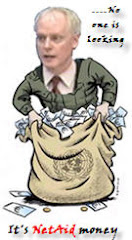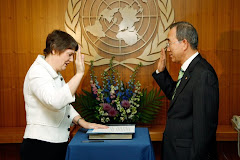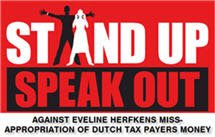EASTAFRICAPRESS.NET
By Karen Rothmyer
Here are three stories culled from the February 17 editions of Kenya’s two largest newspapers, The Daily Nation and The Standard: “Neglect led to famine, say NGOs”; “NGO gives Sh20m for schools upgrade”; “North Rift leads in gender violence” (about an NGO report).What all these stories, and several more on the same day, have in common is that they were generated by one of Kenya’s (and Africa’s) biggest industries, the aid industry. Comprised of over 6,500 registered NGOs, as well as international organisations like UN agencies, Kenya’s aid groups are a major source of news in the form of press conferences, reports and project visits.
If you study such news carefully, as I’ve been doing since 2005, when I returned to Kenya after many years away, you begin to realize that it contains two recurring themes: One is that Kenya has terrible problems; the other is that the aid groups know what to do to solve them.
Local journalists play a key role in getting these messages out, both to the Kenyan public and to the world of donors beyond. Many have what strikes me as a healthier level of scepticism about the aid groups’ activities than their foreign journalistic counterparts. Nevertheless, the local press corps as a whole seems to me to be far too willing to accept aid officials’ statistics, story ideas and view of the world.
“Most journalists follow the frame created by the NGOs,” says a Kenyan journalism instructor who worked for several NGOs earlier in her career. “They are lazy when it comes to reporting. They want quick data and they report it very shallowly.”
The aid groups’ stated objectives are laudable: they want to eliminate the very real problems that exist on the continent. Understandably, in this context, they want to create a sense of urgency about dealing with them. As a practical matter, they also have to attract money. “When you’re fundraising you have to prove there is a need,” says the head of the Kenya office of one large NGO. “Children starving, mothers dying. If you’re not negative enough, you won’t get funding.”
Together, however, these two factors - a desire to call attention to the problems and a need for money to address them - can lead to exaggerated claims and, in turn, distorted news. “They wanted journalists to say ‘Wow,’ they want them to quote your report,” says Nation columnist Rasna Warah, speaking of former aid organisation colleagues. “That means more money for the next report. It’s really as cynical as that.”
Lauren Gelfand, a Nairobi-based correspondent for Jane’s Defence Weekly, got to see an NGO media operation first-hand during a year she took off from journalism to work for Oxfam. “All the talking points are carefully worked out,” she says. “It’s a huge bureaucracy and there are as many levels of control as in any government.”
Gelfand says she remains convinced that most aid workers do what they do because they want to make a difference. Nonetheless, she says, “A lot of what Oxfam does is to sustain Oxfam.”
One recent example of dubious data, and of the way in which it can contribute to distorted news, involves Nairobi’s Kibera neighbourhood, which for several years was increasingly referred to as the largest slum in Africa. One typical locally-written story in early 2010 about the work of a French NGO claimed a population of “between 700,000 and one million people.”
Visiting dignitaries from Barack Obama (when he was a Senator) to entertainers and UN officials have all trooped to Kibera, often accompanied by Kenya government officials who use the opportunity to plead for more assistance. A few months ago, however, the results of Kenya’s 2009 census were released. According to the Kenya National Bureau of Statisics, Kibera has 194,269 residents.
The Daily Nation, to its credit, given that it had done its share of “largest slum” stories, was the first to report the census data (with a slightly different tally), in a September article by Muchiri Karanja. Acidly referring to the “largest slum” characterization as “one big lie”, Karanja described it as a lie that “has been fed to all, from poor residents of the slum who have since grown accustomed to flashing camera lights from tourists taking shots of ‘the biggest slum in Africa’ to schoolchildren who cram the lie everyday in geography classes.”
Karanja’s article was followed by a column by Rasna Warah, who wrote that she was “among those people who have published inflated population estimates for Kibera without having any solid evidence to back up the figures.” This, she said, occurred while she was working for Worldwatch Institute, which got its data from UN-Habitat, where she had also worked.
She said that sometime after 2004, population estimates for Kibera started to rise, and “Before we knew it, the figure spread like a virus…However, even within UN Habitat, there was no consensus on what the actual figure might be.” She added, “The inflated figures were not challenged, perhaps because they were useful to various actors…They were particularly useful to NGOs, which used them to ‘shock’ charities and other do-gooders into donating more money to their projects in Kibera.”
Questionable figures of another sort are to be found in UN and NGO reports on the Millennium Development Goals, a series of UN targets on poverty reduction and other measures of well-being. UN officials have repeatedly described sub-Saharan Africa as failing miserably; for example, UN General Assembly President Srgjan Kerim said in 2007 that “in sub-Saharan Africa we may not achieve a single goal by 2015. This is indeed an emergency situation.”
Here in East Africa, a story in Business Daily in January 2010 quoted a World Bank analysis as saying that “additional aid required to attain the MDGs is somewhere between $40 billion and $60 billion a year.” It concluded that “developing countries are likely to register poor performance on several goals, especially the eradication of extreme poverty unless there is significant improvement in policies and funding in the remaining five-year window.”
Not everyone thinks the picture is quite so gloomy. Some experts, in fact, think that Africa is actually doing reasonably well. But they rarely get quoted in the press. William Easterly, an economist in the US, wrote in 2007 that school enrolments were growing faster in Africa than at a comparable period in Western development. Despite the educational progress, he noted, the continent won’t meet the relevant MDG goal: universal primary school enrolment by 2015.
Easterly has repeatedly raised the possibility that the MDGs were intentionally set in the way they were in order to satisfy the interests of aid groups, a suspicion shared by Jan Vandemoortele, one of the architects of the MDGs. Vandemoortele wrote in a 2009 paper in an academic journal that the MDGs were intended as global targets, but had been improperly applied to individual countries and regions.
“It is a real tragedy when respectable progress in Africa is reported as a failure by international organizations and external observers,” Vandemoortele wrote. He added, “It is unacceptable that targets are set and metrics are selected so as to present Africa as a failure, solely to gain support for a particular agenda, strategy or argument.”
Nonetheless, when the UN met last September to assess progress on the MDGs, most reporting and opinion - in East Africa as elsewhere--continued to reflect the framework of failure. The Associated Press quoted UN Secretary-General Ban Ki-moon as saying, “Many countries are falling short, especially in Africa.”
A Daily Nation editorial of September 16 glumly began: “The latest review of Kenya’s progress toward eliminating hunger and poverty in line with the global development goals makes depressing reading.” A widely-quoted Oxfam report stated that “Unless an urgent rescue package is developed to accelerate fulfillment of all the MDGs, we are likely to witness the greatest collective failure in history.”
If East African journalists are to be in a position to properly evaluate, and sometimes to challenge, the data and assertions of international NGOs and aid agencies, they need to adequately educate themselves about development issues. They also need to cultivate their own sources of data and statistics—think-tanks, academic experts and the like - rather than to rely so heavily on aid agencies. And they need to question descriptions of events that put aid groups at the centre of the action.
Some East African journalists are already doing just that. Salim Amin, the founder of Nairobi-based A24, a video agency inspired by Al Jazeera that packages and sells video news from around the continent, says that his company sometimes uses raw footage from NGOs. But, he says, the NGOs don’t have a say in how the footage will be used.
“If, for example, we want to do a general piece about water issues, maybe we will use material from an NGO that’s working on a water project,” he says. “But we will shape the story.” Amin adds, “A24 will still tell the negative stories, but it will tell them from an African perspective and with African context.”
And finally, East African journalists need to develop their own “lens” through which to view what is going on around them. Too many journalists fall into the easy habit of thinking that “development” equals “foreign-funded project”. But all over Africa, “development” is occurring that has nothing to do with NGOs or aid agencies.
One of the most interesting stories I’ve read in this regard was a piece in The Star (where I’m a consultant) two years ago, written by environment and health specialist John Muchangi. Following up on an invitation from an NGO (but paid for by his employer), Muchangi had gone to visit one of the “Millennium Villages”—a group of 14 sites that have received large amounts of financial and other assistance from western donors. After completing his interviews there, he decided to also check out a nearby village that had no Millennium Village funding but that he’d heard was making impressive progress. According to his report, he found that the second village was doing as well, and in some ways better, than the first, which he concluded was the result of enlightened local leadership.
East Africa needs more of that kind of reporting, and it has plenty of journalists capable of producing it.
Karen Rothmyer has worked for US publications ranging from The Wall St. Journal to a political weekly. This article is adapted from a paper she wrote while a fellow at the Shorenstein Centre on the Press, Politics and Public Policy at Harvard University.

















































No comments:
Post a Comment